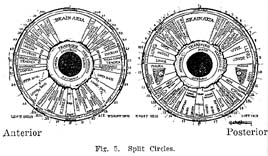
HOME HYGIENE LIBRARY CATALOG TABLE OF CONTENTS GO TO NEXT CHAPTER
Every important part and organ in the body has its corresponding location in the iris in a well defined area, as outlined in the frontispiece.
As long as an organ is in normal condition, the corresponding area in the iris presents the normal color, either light blue or light brown, without any mark, sign or discoloration whatsoever.
When an organ or part of the body undergoes acute or chronic changes as a result of hereditary influences, systemic or drug poisoning, or from mechanical injury, then these pathological changes are recorded in the corresponding area in the iris. Pregnancy, though involving profound changes in the organism, is not indicated in the iris because it is a normal physiological process.
Surgical mutilations of the body performed under anesthesia do not show in the iris, or only very faintly, because anesthesia benumbs and paralyzes the sensory nerves and thereby prevents the transmission of nerve impulses to the iris.
Any substance congenial to the body, i. e., naturally belonging to it, does not show in the iris. All substances not congenial to the body, i. e., those which do not belong to it, such as minerals and earthy elements in the inorganic form, and all poisons, show in the iris in well defined signs and color changes in the areas corresponding to the parts or organs where these substances have accumulated.
The arrangement of the areas in the iris is symmetrical and somewhat in harmony with the location of the various parts and organs in the body. We find the area of the stomach directly around the pupil and the field of the intestines surrounding the region of the stomach. The outer border of the intestinal field, the "sympathetic wreath", corresponds to the sympathetic nervous system, and all other parts and organs of the body radiate from or run into this sympathetic wreath.
All this is in correspondence with conditions in the body. The stomach and intestines are centrally located; they are to the body what the fire-box is to boiler and engine. The entire organism is dependent upon the digestive organs for the elements of nutrition and fuel material.
Every cell and organ in the body depends upon the sympathetic nervous system for its supply of vital energy. All involuntary vital functions and activities are controlled and directed through the sympathetic nervous system. This is indicated in the iris by the fact that the areas of the various parts and organs start or radiate from the sympathetic wreath.
Thus the brain with its divisions, subdivisions and special centers is located in the upper regions of the iris, analogous to the location of the brain in the body. The distinctly human intellectual faculties, capacities and powers are located, in right-handed people, in the left brain hemisphere, but reflected through crossing of the optic nerves into the right iris. In left-handed people the condition is the reverse. The reason for this has been fully explained in Vol. IV, "Eugenics".
The area of the leg is located in the center of the lower half of the iris, etc. Those organs which are located on one side of the body appear only in the corresponding iris. The heart and spleen, for instance, are represented in the left iris. The corresponding halves of organs divided by the median line of the body, such as the nose, mouth, bladder and genital organs, appear in both irides.
The symmetry of the divisions of the iris is much more real than is apparent on superficial examination. This becomes more clear as we study closely the interdependence of the various parts of the body.
The relation between the regions of the iris and the corresponding organs and parts of the body is further illustrated in Fig. 5, which is constructed by the following procedure:

Divide each iris of the regular key vertically through the center. Put the outer halves together and imagine the resulting circle to be as large as the body. Then place the resulting large imaginary circle on the anterior aspect of the body in such a way that the pupil covers the umbilicus.
Similarly, the circle formed by the apposition of the inner halves is placed on the posterior aspect of the body.
By imagining these maps to be vertically and horizontally enlarged so as to cover the entire anterior and posterior aspects of the body, the areas will be found to correspond closely to the different parts of the body.
This symmetrical correspondence of the organ areas in the iris to the location of the organs in the body is conclusive evidence that this arrangement is not accidental, but is in harmony with Nature's definite design and purpose, and thus amply justifies scientific inquiry into the mysterious cypher language of the iris.
HOME HYGIENE LIBRARY CATALOG TABLE OF CONTENTS GO TO NEXT CHAPTER